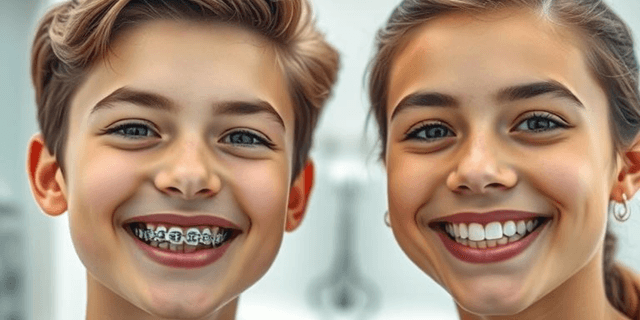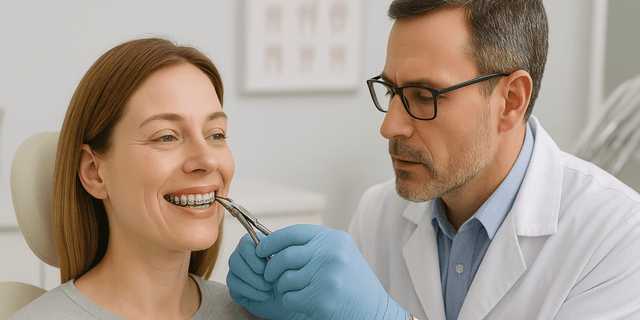Orthodontics
What to Eat (and Avoid) When You Have Braces
Having braces is an effective way to straighten teeth, but the process requires certain adjustments, especially when it comes to eating habits. Choosing the right foods can protect your braces, reduce discomfort, and keep your orthodontic treatment on track.
5 min read
Feb 09, 2025

Life With Braces
Getting a brand‑new brace on each tooth can feel like strapping tiny gym coaches to your smile. They whistle when you forget the rules and cheer when you get them right. Life with braces also means accepting that every snack can either shorten or stretch your treatment time. Take a moment to picture that finish‑line photo: straight teeth, no brackets and wires in sight, no food debris hiding in corners. Keeping that image clear in your mind turns every bite into a conscious choice and makes the journey a lot more fun.
Eat With Braces
You can still eat with braces; you just need fresh playbook moves. First, slow down. Biting hard into crusty bread or crunchy pizza edges sends pressure on your braces that might pop a bracket. Second, cut food into bite‑size pieces so you can chew with your back teeth instead of the front teeth that hold most of the hardware. Third, sip plenty of water while you eat so food particles glide away instead of getting stuck in the braces and around your braces. Eating foods this mindful way quickly feels natural, even in social settings.
Foods to Avoid
Your orthodontist calls them “high‑risk items,” but most of us know them as sticky and hard foods that love to wrestle metal. A short list of foods can damage, bend, or snap the appliance: popcorn kernels, whole nuts, ice cubes, and fruit pits lead the pack. Then come chewy candies—think caramels, taffy, or gum—that adhere to your braces and yank on a wire when you least expect it. It’s best to avoid these mischief‑makers so you don’t add extra appointments or risk of damaging your braces.
Hard Foods
Biting into hard foods like raw carrots or crisp apples feels satisfying, yet that crunch can damage braces and extend treatment. You don’t have to ditch produce; simply slice carrots into thin coins or steam them into softer foods. The same goes for apples, pears, and crusty baguettes: cut them into smaller bits or dip them in soup so they soften. That tiny habit swap removes the bite‑force that could otherwise cause damage to your braces.
Soft Foods
There is a bright side—soft foods are comfort foods. Yogurt with mashed berries, scrambled eggs, tender pasta, and ripe bananas are foods to eat when the brackets feel tender. Softer foods won’t damage your braces, and they’re easier to chew while sore gums settle down. Keep a list of foods you can eat on the fridge so you never stare into the pantry in defeat.
Tips for Eating With Braces
Tip one: brush your teeth at least twice a day, and rinse after snacks if a full scrub isn’t possible. Tip two: use interdental brushes to sweep away food debris between brackets and wires. Tip three: it’s best to carry orthodontic wax; if a rogue wire pokes, wax protects your cheek until you reach the office. Tip four: favor bite‑size pieces and chew slowly—this eases stress on every brace and prevents accidental yanking. Those small habits make sure you maintain your braces and avoid damage that increases treatment time.
Sugary and Acidic Foods
Sugar fuels plaque and spikes the risk of tooth decay, while acidic foods or drinks—think citrus sodas—can etch enamel. You don’t have to swear off soda forever, but it’s best to sip through a straw and rinse afterward. Sugary foods and drinks loved by many teens are fine to eat occasionally, yet foods high in sugar create a sticky film that can’t easily escape, so clean up right away. Your oral health will thank you.
Wire Worries and Bracket Care
A single loose wire can turn lunch into a comedy skit—suddenly you’re searching for a napkin to hide the escapee. To avoid that drama, steer clear of certain foods notorious for snagging wires: chewy bagels, corn on the cob, and rib bones. Should a bracket loosen anyhow, call your orthodontist; early fixes prevent bigger issues. Remember, brackets and wires are partners—treat them gently and they’ll stay on task.
Invisalign and Other Appliances
If you switched to Invisalign or another set of orthodontic appliances, many of these rules still apply. Remove the trays only for meals, stash them in a case (never a napkin that gets tossed), and clean them before they go back in. Even though aligners are clear, foods like turmeric curry or red wine can stain trays fast. Take care of your braces or aligners and you won’t meet unexpected tint surprises.
First Few Days
The first few days after you get your braces are all about tenderness. Your mouth is adjusting to eating soft foods, and gums can bruise if you rush. Start with warm soup, mashed potatoes, or smoothies. Avoid certain foods that tug, like chewy steak, until adjusting to eating with braces feels second nature. A mild saltwater rinse soothes tissues and keeps plaque in check.
Eat After Getting Braces
You can still eat your favorite foods without panic; you just change the game plan. Slice pizza, peel oranges, and rely on utensils more often. Hard taco shells transform into soft tortillas, and you’ll discover new flavors in the process. Follow these pointers and life with braces doesn’t feel like culinary jail. Instead, you’ll finish orthodontic treatment sooner because you dodged emergency repairs.
Braces Come Off
Every orthodontic story ends the same: the day braces come off and a mirror reflects a grin you’ve earned. Ensuring your braces survive intact means wearing a retainer later, but that feels easy compared to the journey. Stick to the tips for eating with braces above, chew with your back teeth whenever possible, and your smile will hit that milestone right on schedule.
Foods and Beverages Cheat Sheet
Sticky foods:
skip caramels, gummy bears, or gum.
Crunchy chips:
crumble them and place at the back teeth if you must.
Chewy foods:
bagels, steak, or licorice strain a wire.
Acidic foods:
lemons, vinegar dressings—rinse afterward.
Soft champions:
oatmeal, hummus, steamed veggies, yogurt.
Final Bite
Braces doesn’t cancel joy; it reshapes it. Avoided with braces doesn’t mean forever banned—it just means “wait a bit.” Follow your orthodontist, pick foods or drinks that won’t damage your braces, and keep a travel brush handy. By doing so you lower the risk of damaging Invisalign trays, metal braces, or clear brackets alike, and you’ll cross the finish line with fewer appointments and a brighter grin.
Read Next
Related Posts

Orthodontics
Traditional Metal Braces vs. Modern Alternatives: Which Is Right for You?
Braces have become almost synonymous with orthodontics, but the choices available today go well beyond what many remember from childhood. Whether you're dealing with crowding, misalignment, or a bite issue, orthodontic treatment can improve both oral health and appearance. And while metal braces are still widely used, alternatives like clear aligners and ceramic braces have expanded what's possible in terms of comfort, aesthetics, and lifestyle compatibility.
11 min read
Apr 03, 2025

Orthodontics
How Long Do I Need to Wear Braces? Factors Affecting Treatment Duration
Orthodontic treatment helps straighten teeth, correct bite issues, and improve oral function. Braces are one of the most common ways to achieve these goals. But one of the first questions people ask is how long they’ll need to wear them. The answer depends on several personal and dental factors.
5 min read
Apr 03, 2025

Orthodontics
Braces and Sports: How to Protect Your Smile During Physical Activities
Braces are a common part of many young athletes’ lives, but they raise a familiar question: how do you stay active without risking your orthodontic progress—or your teeth? Sports, especially those with physical contact, carry an inherent risk of oral injury. Add brackets and wires into the equation, and the stakes go up.
4 min read
Apr 03, 2025
Don’t have time to research every dentist around you?
See why 30k+ patients trusted us